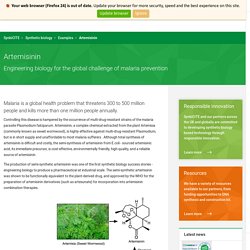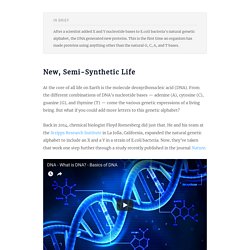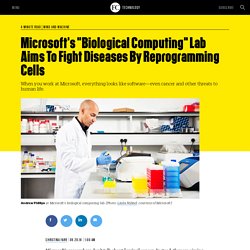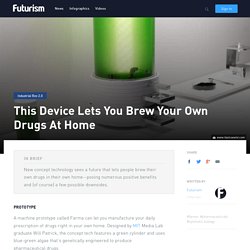

Scientists Are Printing Living “Xenobots” out of Biological Cells. Synthetic Biology Therapies. Controlling this disease is hampered by the occurrence of multi-drug-resistant strains of the malaria parasite Plasmodium falciparum.

Artemisinin, a complex chemical extracted from the plant Artemisia (commonly known as sweet wormwood), is highly effective against multi-drug-resistant Plasmodium, but is in short supply and unaffordable to most malaria sufferers . Glowing, toxin-detecting plants are the green engineering of the future Scientists are no longer barred from developing deadly viruses, and this will definitely end well. If 2017 didn’t already seem like the prologue to every cautionary dystopian tale ever written, the US government has decided to lift a ban on the production of lethal viruses.

The decision comes just three years after the decision to prohibit the intentional creation of deadly pathogens was instituted, and scientists will now be allowed to modify and grow new strains of viruses as long as they get permission first. The lifting of the ban is conditional upon researchers having their plans reviewed and approved by a government panel prior to actually crafting the germs, meaning that scientists will have to explain why they should be allowed to do so, and what potential benefit the research could provide for mankind.
Scientists Just Took a Giant Leap Forward in the Quest to Create Artificial Life. New, Semi-Synthetic Life.

ExxonMobil Announces New Algae Biofuel Research.
This Swimming Stingray Robot Is Powered by Real, Living Rat Cells. This soft robotic stingray is made of rat heart muscle.

Yeah, it's just as crazy as it sounds. "Roughly speaking, we made this thing with a pinch of rat cardiac cells, a pinch of breast implant, and a pinch of gold. That pretty much sums it up, except for the genetic engineering," says Kit Parker, the bio-engineer at Harvard who led the team that developed the strange robot. Microsoft's "Biological Computing" Lab Aims To Fight Diseases By Reprogramming Cells. Microsoft's researchers don't talk about "curing" cancer.

Instead, they are aiming to "solve" it. The technology behemoth is best known for its operating systems and business software, and since 2014, under CEO Satya Nadella, it's focused much of its energy on plotting a future for mainstay products such as Windows and Office. But the company has also quietly built up a presence in medical research. In Cambridge, U.K., it has 150 scientists and software developers working on a wide variety of projects at its little-known "biological computation" unit, which includes a newly installed wet lab. The company says its eventual goal is to make cells into living computers that could someday be programmed—and even reprogrammed—to treat diseases like cancer.
This Genetically-Engineered Bacteria Can Inhale CO2 and Produce Energy. Newest Discovery Moves Us One Step Closer To Making Synthetic Organisms With Reverse Biochemistry. Southpaw DNA and Righty Amino Acids One of the great mysteries of life concerns what is called life’s “chirality”—that is, its “handedness.”

Just like you and I, the very macromolecules that make up our cells exhibit “left-handed” or “right-handed” tendencies; it’s strange and maybe counterintuitive, but a molecule of a certain chirality is incompatible with its mirror-image complement, like a right-handed and left-handed glove. In the case of terrestrial life, amino acids are always left-handed, and DNA twists in a clockwise fashion. Who knows why—perhaps it was merely chance, or perhaps the weak nuclear force governing subatomic particles, which also exhibits “handedness,” tipped the balance just enough in the early days of evolution to fossilize the present chirality preferences into life. This Device Lets You Brew Your Own Drugs At Home. Prototype A machine prototype called Farma can let you manufacture your daily prescription of drugs right in your own home.

Designed by MIT Media Lab graduate Will Patrick, the concept tech features a green cylinder and uses blue-green algae that’s genetically engineered to produce pharmaceutical drugs. After the drugs are produced, the device then measures, filters, and dries it into a powder. Once in powder form, it can then be molded into pill form. Image credit: Farma.
'Squid teeth' plastic self-heals with water. Scientists derived the genetic code of squid ring teeth to develop a polymer that self-heals with a single drop of water.

The material potentially could extend the life of medical implants, fiber-optic cables, and other hard-to-repair objects, researchers say. Another Milestone in Hybrid Artificial Photosynthesis. Laser technique for low-cost self-assembly of nanostructures. The Pentagon Is Putting Big Money Into Synthetic Biology - BuzzFeed News. New DNA construct can set off a “mutagenic chain reaction” A technique for editing genes while they reside in intact chromosomes has been a real breakthrough.

Literally. In 2013, Science magazine named it the runner-up for breakthrough-of-the-year, and its developers won the 2015 Breakthrough Prize. The system being honored is called CRISPR/Cas9, and it evolved as a way for bacteria to destroy viruses using RNA that matched the virus' DNA sequence. But it's turned out to be remarkably flexible, and the technique can be retargeted to any gene simply by modifying the RNA. Researchers are still figuring out new uses for the system, which means there are papers coming out nearly every week, many of them difficult to distinguish.
That may be precisely why the significance of a paper published last week wasn't immediately obvious. Nanocrafter: Playing a Game of Synthetic Biology - Citizen Science Salon : Citizen Science Salon. Image Credit: Nanocrafter On its surface, it looks like just another science puzzle game.

In reality, the game is part of a broader goal to enable non-scientists to contribute to synthetic biology research. ‘It’ is Nanocrafter, a project created by researchers and game developers at the Center for Game Science at the University of Washington. They are the same team behind the citizen science project FoldIt. “Most citizen science games are designed to gather data for a specific research question. Nicholas Negroponte on Biotechnology and Future Learning.
By Big Think Editors When Nicholas Negroponte spoke at the inaugural TED event in 1984, he made five predictions (though he calls them extrapolations) that more or less came true. Artificial Enzymes from Artificial DNA Challenge Life As We Know It. Artificial Enzymes from Artificial DNA Challenge Life As We Know It In the decade or so since the Human Genome Project was completed, synthetic biology has grown rapidly. Impressive advances include the first bacteria to use a chemically-synthesized genome and creation of a synthetic yeast chromosome. Recently, scientists from the MRC Laboratory of Molecular Biology in Cambridge, led by Dr. Philip Hollinger, reported creating the first completely artificial enzymes that are functional. The breakthrough was published in the journal Nature and builds on prior success by the group in creating several artificial nucleotides. Y Combinator, Move Over For IndieBio: A Second Biotech Accelerator. Bernadette Tansey10/9/14 Y Combinator, which set off a whirlwind of skeptical commentary when it opened its highly ranked tech accelerator program to biotechnology startups last spring, now has some company.
SOS Ventures, the international VC firm that already holds accelerator programs for software and hardware company founders, is launching a separate accelerator called IndieBio in San Francisco and the city of Cork, Ireland, for entrepreneurial teams in fields that include synthetic biology. Like Mountain View, CA-based Y Combinator, SOS Ventures is betting that innovators in certain biotech sectors—bioinformatics, automated lab technology, and the intensive form of genetic engineering known as synthetic biology—can profit from the jumpstart delivered by accelerator programs. Hagfish Slime: Biomaterial Of The Future? I don’t like to admit that there are many things that are as badass in the marine world as sharks, but hagfish definitely give them a run for their money.
Hagfish are primitive, eel-like creatures that spend most of their lives slithering along the ocean floor, scavenging dead and dying fish. They’re spineless, virtually blind, have no jaws and have barely changed over the last 300 million years. They’re not sounding very tough right now, so what makes them so special? Well, hagfish have a sticky trick up their sleeves. When attacked or threatened, they exude a gelatinous slime into the water that can quickly smother the gills and mouth of a predator, thwarting the attack. Seven fabrics inspired by nature: from the lotus leaf to butterflies and sharks.
With technology poised to change the way we dress in the future, here are seven examples of innovative fabrics that take their cue from the natural world. Movie: Julian Melchiorri on the first synthetic biological leaf. The "first man-made biological leaf" could enable humans to colonise space. Two New Letters for the DNA Alphabet. Biodegradable Plastic Option From Shrimp Shells. Scientists Engineer First Bone Marrow-On-A-Chip. If synthetic biologists think like scientists, they may miss their eureka moment. Bioengineers Build Circuit Board Modeled On The Human Brain. Bio-inspired transparent synthetic materials could protect cars and people. This Could Be the First Animal to Live Entirely Inside a Computer.
DNA nanobots deliver drugs in living cockroaches - health - 08 April 2014. Self-healing engineered muscle grown in ‘bionic mouse’ Erasing A Genetic Mutation. Engineered bacteria produce biofuel alternative for high-energy rocket fuel. Engineers design 'living materials': Hybrid materials combine bacterial cells with nonliving elements that emit light. Reprogrammed Bacteria Build Self-Healing 'Living Materials' Monsanto Owns Us: The Monopoly of Seeds and Intellectual Property Rights. 'Iron Man' plants are supercharged by nanotech power - life - 16 March 2014. Trends in Biotechnology - Biotechnological potential of the fungal CTG clade species in the synthetic biology era. How Food Poisoning (E.Coli) Could be the Future Bio-fuel. Scientists discover double meaning in genetic code. Proto-Organelles for Synthetic Cells. SynBio Consulting. Gut Microbes and Autism. New method of DNA editing allows synthetic biologists to unlock secrets of a bacterial genome.
Human stem cells converted to functional lung cells. Advancements in High-Speed DNA Synthesis to Drive Growth in the Global Synthetic Biology Market, According to New Report by Global Industry Analysts, Inc. Engineering Life. Glowing plants and DIY bio succeed on Kickstarter. Glowing Plant. Organs on Demand. Converting fat cells from liposection to liver cells in nine days — a regenerative medicine breakthrough.